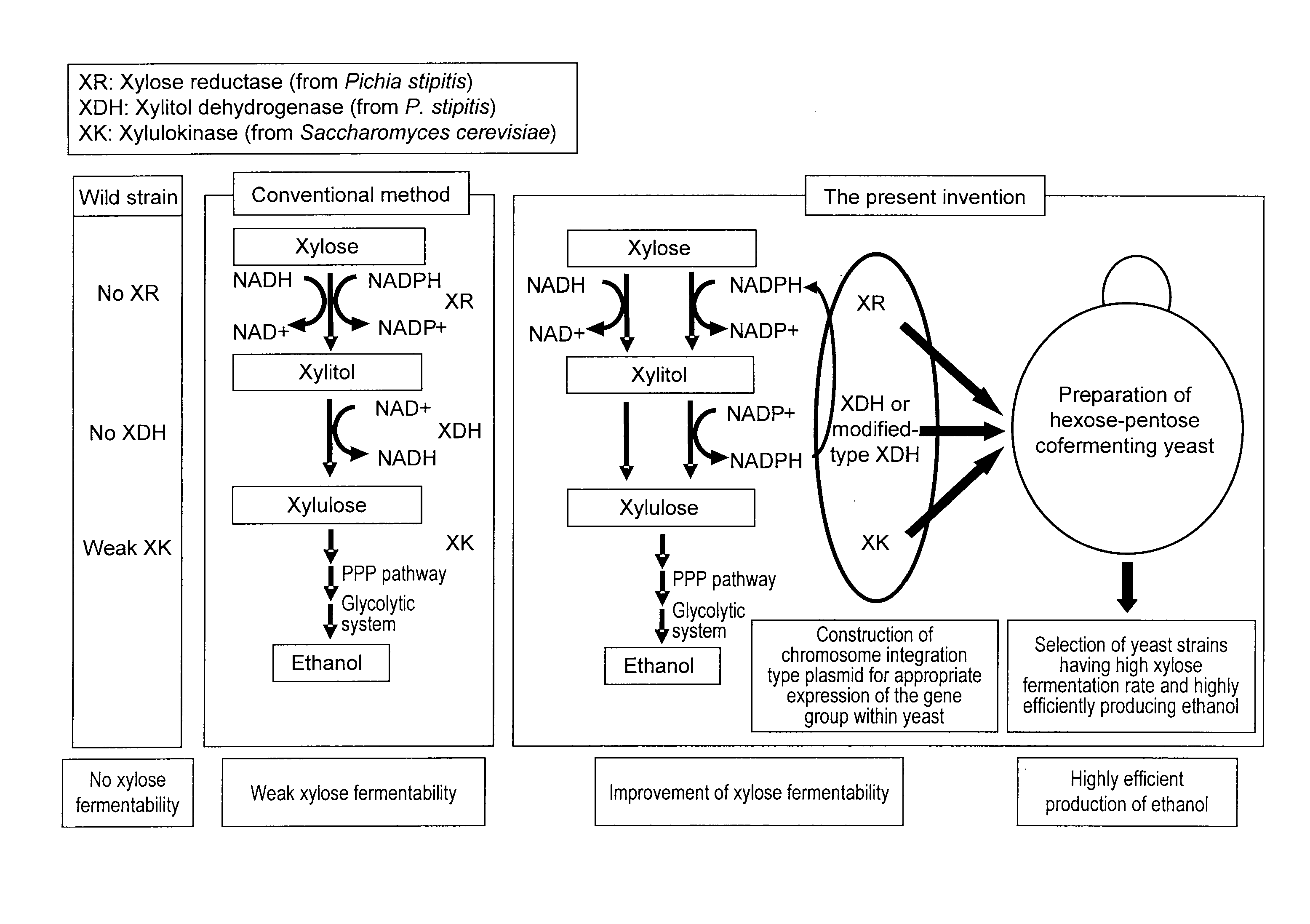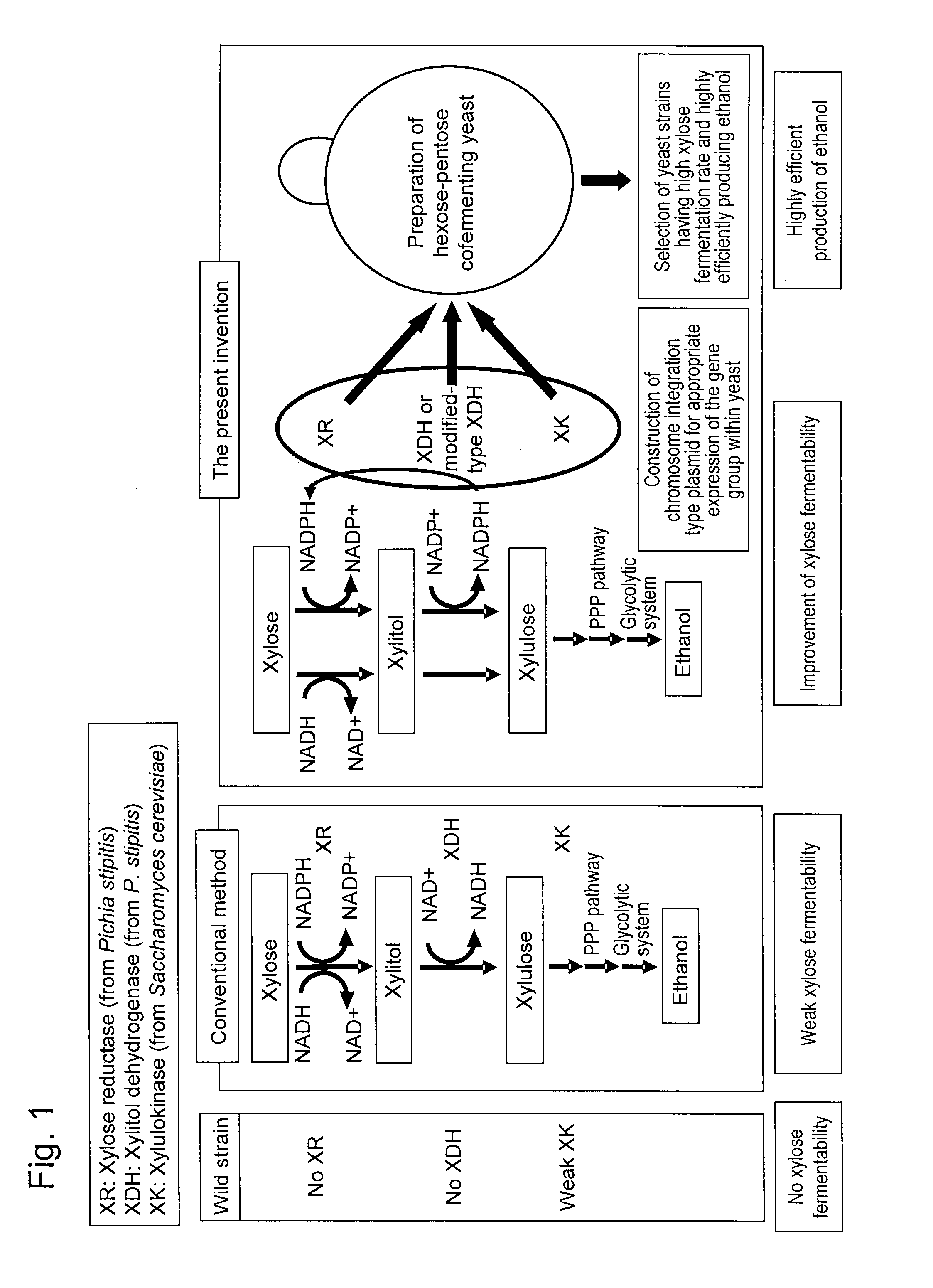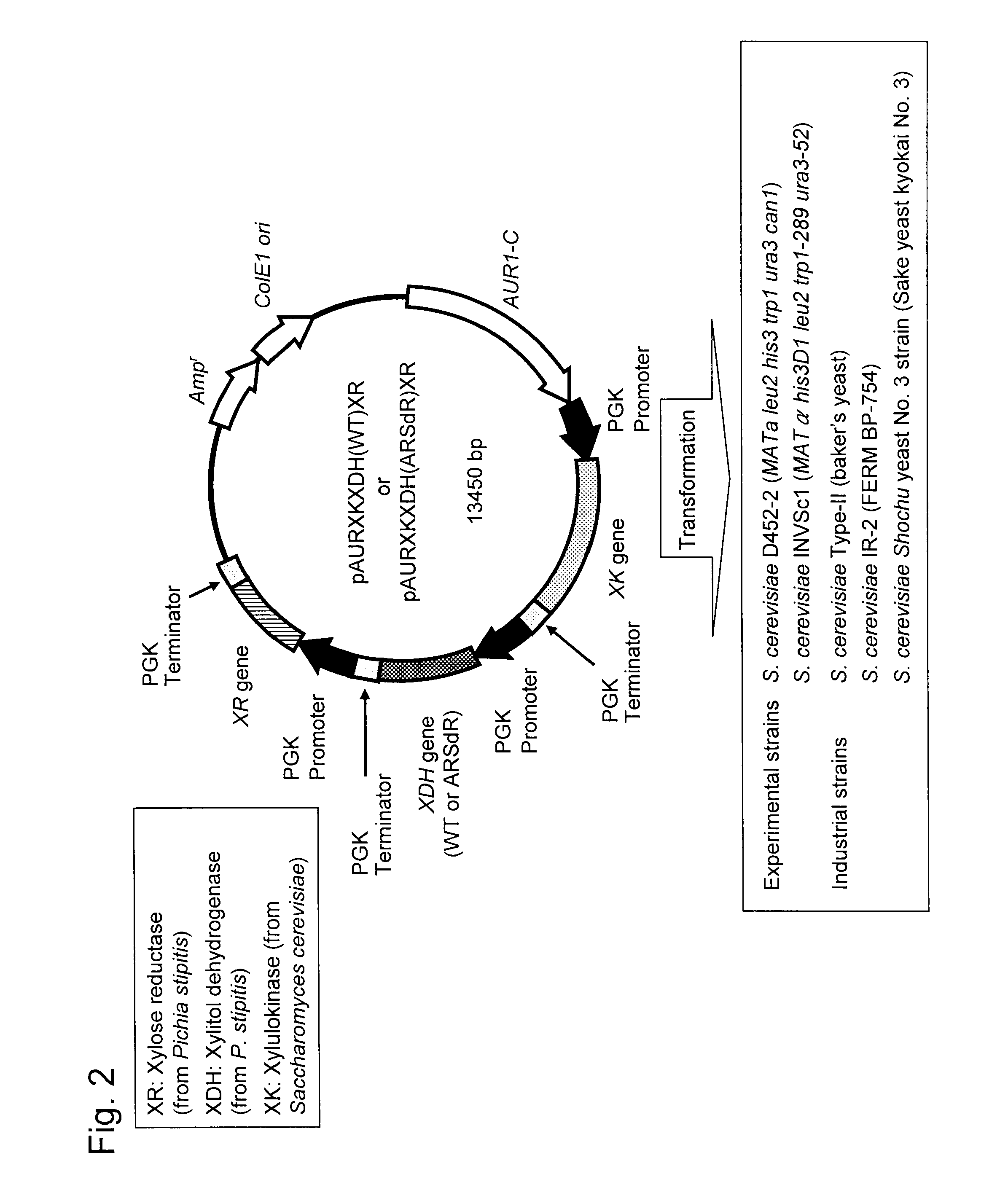Hexose-pentose cofermenting yeast having excellent xylose fermentability and method for highly efficiently producing ethanol using the same
a technology of hexosepentose and cofermenting yeast, which is applied in the direction of biofuels, enzymology, transferases, etc., can solve the problems of limited microorganisms that can use xylose richly in the saccharified solution of wood-based biomass, and achieve high xylose fermentation rate, high yield, and efficient conversion of xylose to ethanol
- Summary
- Abstract
- Description
- Claims
- Application Information
AI Technical Summary
Benefits of technology
Problems solved by technology
Method used
Image
Examples
example 1
Preparation of pBS-PGK-XR-PGK
[0080]For preparation of a wild-type XR gene, the following two primers were designed in reference to the Pichia stipitis XR gene registered at GeneBank (Registration No. XM—001385144) (SEQ ID NO: 2). In addition, a BamH I recognition site was added to the 5′ terminal portion of the XR gene to prepare a primer and an Hind III recognition site was added to the 3′ terminal portion of the XR gene to prepare the other primer.
(SEQ ID NO: 3)5′-GCATaagcttATGCCTTCTATTAAGTTGAACTCTGG-3′(SEQ ID NO: 4)5′-TAAggatccTTAGACGAAGGATAGGAATCTTGTCC-3′
[0081]PCR was carried out using Blend Taq DNA polymerase (Toyobo Co., Ltd.). With the use of primers (10 pmol each) and 100 ng of P. stipitis genomic DNA, the XR gene was amplified under conditions involving a denaturation reaction at 94° C. for 30 seconds, an annealing reaction at 55° C. for 30 seconds, and an extension reaction at 72° C. for 1 minute. The thus obtained DNA fragment was introduced into the Hind III and BamH I r...
example 2
Preparation of pPGK-XDH (WT)
[0083]For preparation of a wild-type XDH gene, the following two primers were designed in reference to the Pichia stipitis XDH gene registered at GeneBank (Registration No. AF127801 or X55392) (SEQ ID NO: 7). In addition, an EcoR I recognition site was added to the 5′ terminal portion of the XDH gene to prepare a primer and a BamH I recognition site was added to the 3′ terminal portion of the XDH gene to prepare the other primer.
(SEQ ID NO: 8)5′-CATgaattcATGACTGCTAACCCTTCCTTGGTG-3′(SEQ ID NO: 9)5′-TAAggatccTTACTCAGGGCCGTCAATGAGAC-3′
[0084]PCR was carried out using Blend Taq DNA polymerase (Toyobo Co., Ltd.). With the use of primers (10 pmol each) and 100 ng of P. stipitis genomic DNA, the XDH gene was amplified under conditions involving a denaturation reaction at 94° C. for 30 seconds, an annealing reaction at 60° C. for 30 seconds, and an extension reaction at 72° C. for one minute and 30 seconds. The thus obtained DNA fragment was introduced into EcoR I...
example 3
Construction of pPGK-XK
[0085]For preparation of a wild-type XK gene, the following two primers were designed in reference to the Saccharomyces cerevisiae XK gene registered at GeneBank (NC—001139.7) (SEQ ID NO: 10). In addition, an EcoR I recognition site was added to the 5′ terminal portion of the XK gene to prepare a primer and a BamH I recognition site was added to the 3′ terminal portion to prepare the other primer.
(SEQ ID NO: 11)5′-CATgaattcATGTTGTGTTCAGTAATTCAGAGACAGAC-3′(SEQ ID NO: 12)5′-TAAggatccTTAGATGAGAGTCTTTTCCAGTTCGC-3′
PCR was carried out using Blend Taq DNA polymerase (Toyobo Co., Ltd.). With the use of primers (10 pmol each) and 100 ng of S. cerevisiae genomic DNA, the XK gene was amplified under conditions involving a denaturation reaction at 94° C. for 30 seconds, an annealing reaction at 54° C. for 30 seconds, and an extension reaction at 72° C. for 2 minutes. The thus obtained DNA fragment was introduced into the EcoR I and BamH I restriction enzyme cleavage sites...
PUM
| Property | Measurement | Unit |
|---|---|---|
| temperature | aaaaa | aaaaa |
| temperature | aaaaa | aaaaa |
| temperature | aaaaa | aaaaa |
Abstract
Description
Claims
Application Information
 Login to View More
Login to View More - R&D
- Intellectual Property
- Life Sciences
- Materials
- Tech Scout
- Unparalleled Data Quality
- Higher Quality Content
- 60% Fewer Hallucinations
Browse by: Latest US Patents, China's latest patents, Technical Efficacy Thesaurus, Application Domain, Technology Topic, Popular Technical Reports.
© 2025 PatSnap. All rights reserved.Legal|Privacy policy|Modern Slavery Act Transparency Statement|Sitemap|About US| Contact US: help@patsnap.com



